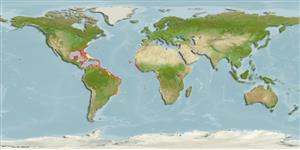>
Carangiformes (Jacks) >
Carangidae (Jacks and pompanos) > Caranginae
Etymology: Caranx: French, carangue, the name of a Caribbean fish; 1836 (Ref. 45335).
More on author: Agassiz.
Environment: milieu / climate zone / Tiefenbereich / distribution range
Ökologie
seewasser; süßwasser; brackwasser riff-verbunden; oceano-estuarine (Ref. 4233); tiefenbereich 0 - 140 m (Ref. 36484), usually 0 - 20 m (Ref. 40849). Subtropical; 41°N - 23°S, 98°W - 14°E
Western Atlantic: New Jersey (USA), Bermuda, and northern Gulf of Mexico to São Paulo, Brazil (Ref. 57756). Eastern Atlantic: St. Paul's Rocks (Ref. 13121), Ascension Island, and two confirmed records from the Gulf of Guinea (Ref. 7097).
Length at first maturity / Size / Gewicht / Alter
Geschlechtsreife: Lm 37.0, range 34 - ? cm
Max length : 101 cm FL Männchen/unbestimmt; (Ref. 40637); common length : 60.0 cm TL Männchen/unbestimmt; (Ref. 5217); max. veröff. Gewicht: 13.4 kg (Ref. 40637)
Rückenflossenstacheln (insgesamt) : 8 - 9; Rückenflossenweichstrahlen (insgesamt) : 20 - 22; Afterflossenstacheln: 2 - 3; Afterflossenweichstrahlen: 16 - 17. Diagnosis: chest fully scaled (Ref. 81654). No spots on pectoral fins, spot posteriorly on gill cover small or absent; scutes tend to be dusky or blackish; caudal fin yellow; young with broad blackish bars on body (Ref. 13442).
Body shape (shape guide): fusiform / normal.
A pelagic (Ref. 26340) schooling species usually found in offshore reefs (Ref. 9710). Juveniles are encountered along shores of sandy beaches, also over muddy bottoms (Ref. 9626). May penetrate into brackish water and ascend rivers. Adults feed on fishes, shrimps, and other invertebrates (Ref. 3277). Often approach divers (Ref. 9710). Eggs are pelagic (Ref. 4233).
Robins, C.R. and G.C. Ray, 1986. A field guide to Atlantic coast fishes of North America. Houghton Mifflin Company, Boston, U.S.A. 354 p. (Ref. 7251)
IUCN Rote Liste Status (Ref. 130435: Version 2024-2)
Bedrohung für Menschen
Reports of ciguatera poisoning (Ref. 31172)
Nutzung durch Menschen
Fischereien: weniger kommerziell; Sportfisch: ja; Aquarium: Kommerziell
Tools
Zusatzinformationen
Download XML
Internet Quellen
Estimates based on models
Preferred temperature (Ref.
123201): 23.4 - 28, mean 26.5 °C (based on 642 cells).
Phylogenetic diversity index (Ref.
82804): PD
50 = 0.5000 [Uniqueness, from 0.5 = low to 2.0 = high].
Bayesian length-weight: a=0.01738 (0.01127 - 0.02680), b=2.93 (2.81 - 3.05), in cm total length, based on LWR estimates for this species & Genus-body shape (Ref.
93245).
Trophic level (Ref.
69278): 4.2 ±0.4 se; based on diet studies.
Widerstandsfähigkeit (Ref.
120179): mittel, Verdopplung der Population dauert 1,4 - 4,4 Jahre. (Preliminary K or Fecundity.).
Prior r = 0.28, 95% CL = 0.18 - 0.42, Based on 2 data-limited stock assessments.
Fishing Vulnerability (Ref.
59153): High to very high vulnerability (67 of 100).
🛈
Nutrients (Ref.
124155): Calcium = 10.8 [4.5, 19.0] mg/100g; Iron = 0.333 [0.174, 0.672] mg/100g; Protein = 20.8 [18.6, 23.3] %; Omega3 = 0.205 [0.116, 0.354] g/100g; Selenium = 23.8 [10.4, 53.4] μg/100g; VitaminA = 42.1 [12.5, 138.5] μg/100g; Zinc = 0.343 [0.235, 0.533] mg/100g (wet weight);
